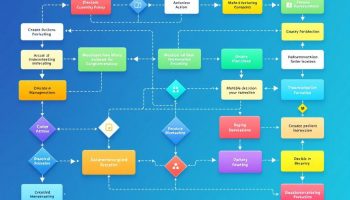
Understanding Lean Supply Principles
Lean supply principles—Just-In-Time inventory management, Value Stream Mapping, Continuous Flow Implementation, Pull-Based Supply Systems, and Total Quality Management—create the foundation for efficient supply chain operations in today’s competitive business landscape. These five key strategies combine to eliminate waste, optimize processes, and develop value-driven supply chains that respond quickly to customer needs.
Driving Business Performance Through Lean Implementation
Implementing lean supply principles helps your organization significantly cut operational costs while improving responsiveness to market demands. When you adopt Just-In-Time inventory and pull-based systems, you’ll minimize storage expenses and free up working capital that would otherwise be locked in excess inventory. Value Stream Mapping identifies inefficiencies and bottlenecks, enabling targeted process improvements that directly boost your bottom-line results.
Cross-functional training and continuous flow implementation create an adaptable workforce that maintains productivity despite disruptions. Most importantly, Total Quality Management integrated throughout your supply chain reduces defects and rework, boosting customer satisfaction and retention while lowering costs. This creates a sustainable competitive advantage in challenging markets.
By applying lean supply principles consistently, you’ll transform your supply chain from a cost center into a strategic asset. Your operations can become more agile, responsive, and cost-effective—essential qualities for success in today’s fast-paced business environment.
Explore 5 Essential Lean Supply Principles for Optimizing Your Operations: Take Action Today!
In the world of supply chain management, adopting lean supply principles is crucial for organizations aiming to enhance efficiency and reduce waste. This section outlines five key strategies that will empower you to streamline your processes and better align your supply chain with customer demands. Each principle serves as a building block for continuous improvement, enabling companies to respond more agilely to changes in the marketplace. Whether you’re looking to optimize inventory management through Just-In-Time (JIT) systems, visualize your supply chain with value stream mapping, or foster a culture of quality excellence with Total Quality Management (TQM), embracing these principles is vital for achieving operational success. Dive into each topic to discover actionable insights that can significantly transform your supply chain practices.
“`html
1. Just-In-Time (JIT) Inventory Management
JIT inventory management is a cornerstone of lean supply principles that revolutionizes how companies manage their supply chains. By implementing JIT strategies, you can significantly reduce storage costs and minimize waste throughout your operations. This approach synchronizes supply directly with demand, ensuring products arrive exactly when needed rather than sitting in warehouses.
Real-time inventory tracking systems play a crucial role in JIT implementation, providing visibility across your entire supply network. These systems alert you to potential shortages before they occur and help maintain optimal inventory levels aligned with lean supply principles.
Effective supplier relationship management becomes essential when adopting JIT. You’ll need to develop collaborative partnerships with suppliers who can deliver smaller, more frequent shipments with consistent quality and timing. This requires:
- Clear communication channels
- Shared performance metrics
- Joint problem-solving approaches
- Transparent forecasting information
When properly implemented, JIT inventory management reduces carrying costs, minimizes obsolescence, and creates a more responsive supply chain aligned with core lean supply principles.
“`
2. Value Stream Mapping
Value stream mapping is a fundamental lean supply principles tool that visualizes your entire supply chain process from start to finish. When implementing lean supply principles effectively, you must first identify where waste exists in your current operations. This visualization technique helps you distinguish between value-adding and non-value-adding activities by creating a detailed flowchart of information and material flows.
Process flow optimization becomes possible once you’ve mapped your entire supply chain. You can implement optimization methods to eliminate bottlenecks and reduce lead times, creating a smoother operation that aligns with core lean supply principles. The goal is to create a streamlined process where each step contributes meaningful value.
Waste elimination strategies form the cornerstone of effective value stream mapping. By categorizing waste into the eight types recognized in lean methodology (defects, overproduction, waiting, non-utilized talent, transportation, inventory, motion, and extra-processing), you can systematically address each area. This targeted approach ensures you’re addressing the root causes of inefficiency rather than symptoms.
Key benefits of implementing value stream mapping include:
- Reduced lead times by up to 50% in many organizations
- Decreased inventory levels while maintaining service levels
- Improved cross-functional communication and collaboration
- Enhanced visibility of supply chain vulnerabilities
Performance metrics tracking completes the value stream mapping process by establishing KPIs that monitor improvement over time. These metrics should align with your overall lean supply principles implementation goals and provide actionable insights for continuous improvement.
Expert Insight: To maximize the benefits of value stream mapping, meticulously identify and categorize waste in your supply chain to address root causes. Utilize insights from your visualized process to implement optimization strategies, thereby enhancing efficiency and reducing lead times. Consistently track performance metrics to sustain continuous improvement aligned with lean principles.
3. Continuous Flow Implementation in Lean Supply Principles
Implementing continuous flow is a cornerstone of lean supply principles that eliminates wasteful stops and starts in your production process. By adopting one-piece flow systems, you can reduce batch processing that often leads to inventory buildup and quality issues. This approach requires careful work cell optimization where equipment and workstations are arranged to minimize transportation and waiting time between operations.
Cross-training your workforce is essential for maintaining lean supply principles throughout your operation. When team members can perform multiple functions, you gain flexibility to address bottlenecks and maintain continuous flow even during absences. This versatility supports continuous improvement efforts and enhances problem-solving capabilities across departments.
Equipment layout improvements represent another critical component of flow implementation. Strategic placement of machinery reduces unnecessary movement and supports the natural progression of materials through your facility. Consider these key layout strategies:
- Arranging workstations in U-shaped cells to minimize walking distances
- Positioning related processes adjacent to each other
- Ensuring adequate space for material handling equipment
- Creating visual management systems to identify flow disruptions
When properly executed, continuous flow implementation creates a more responsive supply chain that can adapt quickly to changing customer demands while maintaining optimal efficiency levels.
Expert Insight: To implement continuous flow in lean supply principles, focus on optimizing work cell layouts and cross-training staff for versatility. This enhances flexibility, minimizes waste, and improves responsiveness to changes. Streamlined processes and effective equipment placement are essential for maintaining efficiency and supporting ongoing continuous improvement efforts.
4. Pull-Based Supply Systems
Implementing pull-based supply systems is a cornerstone of lean supply principles that dramatically improves efficiency. Instead of pushing products through your supply chain based on forecasts, pull systems respond directly to actual customer demand. By embracing Kanban implementation, you create a visual signaling system that triggers production only when needed, minimizing excess inventory and reducing waste.
Demand-driven production aligns perfectly with lean thinking principles by ensuring you manufacture only what customers want, when they want it. This approach requires:
- Clear visual signals between workstations
- Standardized work processes
- Cross-functional team communication
- Regular cycle time analysis
Buffer stock optimization becomes more scientific under pull systems, allowing you to maintain just enough inventory to handle variations in demand while avoiding overstocking. You’ll need to regularly review buffer levels and adjust based on actual consumption patterns.
Order fulfillment efficiency improves naturally when you implement pull systems, as the entire supply chain becomes more responsive to real demand. This process improvement in supply chain operations reduces lead times and increases customer satisfaction by delivering exactly what’s needed without excess.
Expert Insight: Implement pull-based supply systems to enhance efficiency by aligning production with actual customer demand. Use visual signals and standardized processes to minimize excess inventory and waste, while optimizing buffer stocks. This approach improves order fulfillment, reduces lead times, and boosts customer satisfaction by delivering precisely what is needed.
5. Total Quality Management (TQM)
Implementing lean supply principles through Total Quality Management creates a foundation for operational excellence. TQM integrates quality control directly into your supply chain processes rather than relying on end-stage inspections. By focusing on quality at the source, you prevent defects from moving downstream, significantly reducing waste and rework costs.
Defect prevention methods form a crucial component of TQM in lean supply chains. These include:
- Statistical process control
- Mistake-proofing (poka-yoke)
- Standardized work procedures that ensure consistency
When suppliers and manufacturers follow these preventive approaches, the entire supply chain benefits from fewer disruptions and higher quality outputs.
Employee empowerment is essential for effective implementation of lean supply principles within TQM. By providing workers with:
- Authority to stop production when quality issues arise
- Training on problem-solving techniques
- Resources to implement improvements
- Recognition for quality contributions
This empowerment creates ownership and accountability throughout the supply chain. Organizations that implement continuous improvement cultures can sustain their lean supply initiatives over time. Regular kaizen events, cross-functional improvement teams, and systematic problem-solving approaches keep your supply chain evolving toward greater efficiency and effectiveness.
Expert Insight: To achieve operational excellence through Total Quality Management, embed quality control into supply chain processes and empower employees to address quality issues proactively. Utilize defect prevention techniques to enhance consistency and minimize waste. Foster a culture of continuous improvement to sustain lean initiatives and drive ongoing efficiency.
Lean Supply Principles
Lean supply principles encompass five key strategies: Just-In-Time inventory management, value stream mapping, continuous flow implementation, pull-based systems, and Total Quality Management, all designed to optimize efficiency throughout supply chains. These principles work together to eliminate waste, reduce lead times, improve quality, and create responsive operations that deliver exactly what customers need when they need it.
Importance of Implementing Lean Principles
Implementing lean supply principles is essential for modern enterprises seeking to remain competitive in increasingly complex global markets. Organizations that embrace these methodologies can achieve significant:
- Cost reductions
- Enhanced quality control
- Improved cash flow
- Increased customer satisfaction
While simultaneously building supply chains resilient enough to withstand disruptions and agile enough to capitalize on emerging opportunities.






